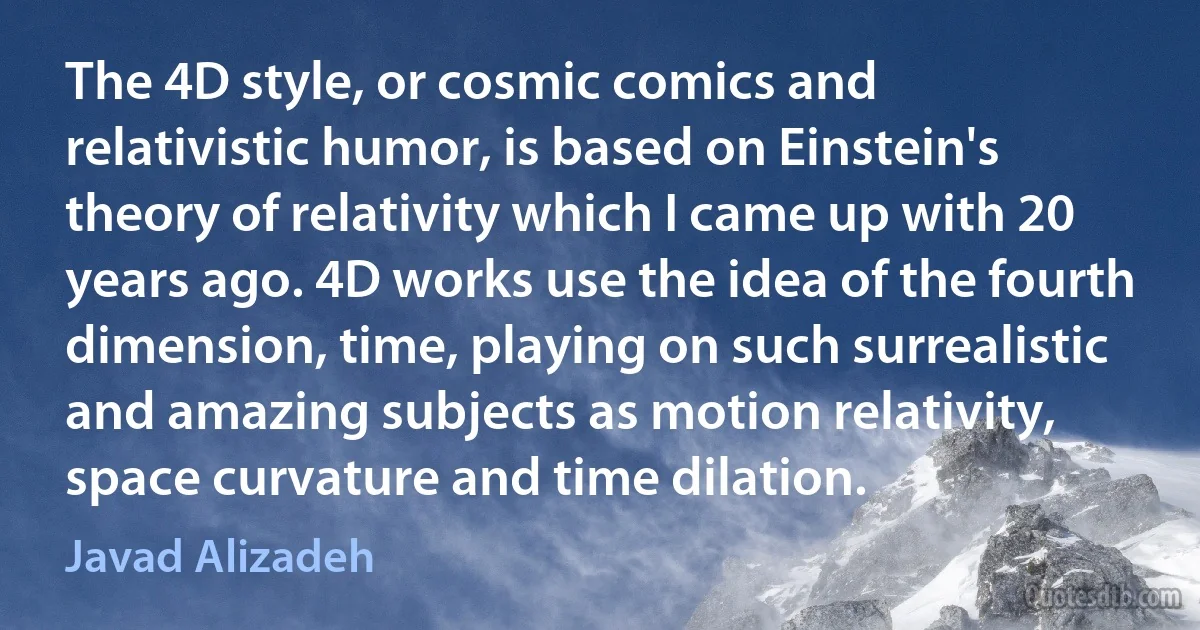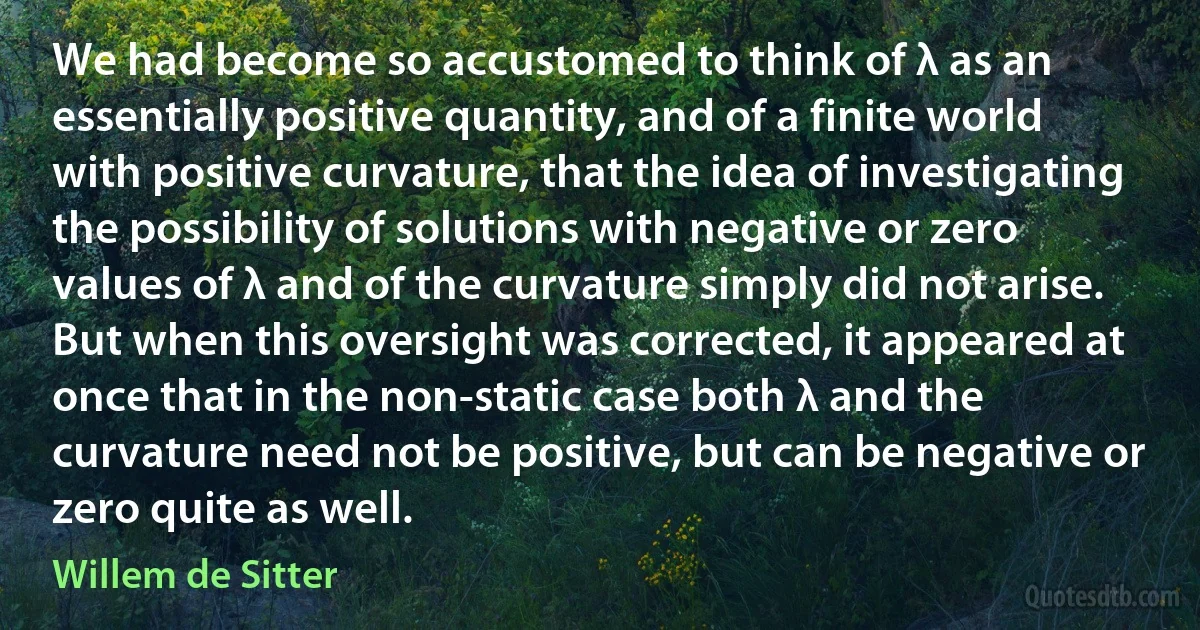Curvature Quotes
To the pure geometer the radius of curvature is an incidental characteristic - like the grin of the Cheshire cat. To the physicist it is an indispensable characteristic. It would be going too far to say that to the physicist the cat is merely incidental to the grin. Physics is concerned with interrelatedness such as the interrelatedness of cats and grins. In this case the "cat without a grin" and the "grin without a cat" are equally set aside as purely mathematical phantasies.

Arthur Eddington
I have always been interested in oval or ovoid shapes. The first carvings were simple realistic oval forms of the human head or of a bird. Gradually my interest grew in more abstract values – the weight, poise and curvature of the ovoid as a basic form. The carving and piercing of such a form seems to open up an infinite variety of continuous curves in the third dimension, changing in accordance with the contours of the original ovoid and with the degree of penetration of the material. Here is a sufficient field for exploration to last a lifetime..

Barbara Hepworth
Any region of space-time that has no gravitating mass in its vicinity is uncurved, so that the geodesics here are straight lines, which means that particles move in straight courses at uniform speeds (Newton's first law). But the world-lines of planets, comets and terrestrial projectiles are geodesics in a region of space-time which is curved by the proximity of the sun or earth... No force of gravitation is... needed to impress curvature on world-lines; the curvature is inherent in the space...

James Jeans
I hold in fact
(1) That small portions of space are in fact of a nature analogous to little hills on a surface which is on the average flat; namely, that the ordinary laws of geometry are not valid in them.
(2) That this property of being curved or distorted is continually being passed on from one portion of space to another after the manner of a wave.
(3) That this variation of the curvature of space is what really happens in that phenomenon which we call the motion of matter, whether ponderable or etherial.
(4) That in the physical world nothing else takes place but this variation, subject possibly to the law of continuity.

William Kingdon Clifford
Riemann has shewn that as there are different kinds of lines and surfaces, so there are different kinds of space of three dimensions; and that we can only find out by experience to which of these kinds the space in which we live belongs. In particular, the axioms of plane geometry are true within the limits of experiment on the surface of a sheet of paper, and yet we know that the sheet is really covered with a number of small ridges and furrows, upon which (the total curvature not being zero) these axioms are not true. Similarly, he says although the axioms of solid geometry are true within the limits of experiment for finite portions of our space, yet we have no reason to conclude that they are true for very small portions; and if any help can be got thereby for the explanation of physical phenomena, we may have reason to conclude that they are not true for very small portions of space.

William Kingdon Clifford
Today we know that on the sub-atomic level the fate of an electron or a whole atom is not determined by its past. But this discovery has not led to any basically new departure in the philosophy of nature, only to a state of bewildered embarrassment, a further retreat of physics into a language of even more abstract symbolism. Yet if causality has broken down and events are not rigidly governed by the pushes and pressures of the past, may they not be influenced in some manner by the "pull" of the future-which is a manner of saying that "purpose" may be a concrete physical factor in the evolution of the universe, both on the organic and unorganic levels. In the relativistic cosmos, gravitation is a result of the curvature and creases in space which continually tend to straighten themselves out-which, as Whittaker remarked, "is a statement so completely teleological that it certainly would have delighted the hearts of the schoolmen."

Arthur Koestler
It was early 1932, when Einstein and I both were at the California Institute of Technology in Pasedena, and we just decided to look for a simple relativistic model that agreed reasonably well with the known observational data, namely, the Hubble recession rate and the mean density of matter in the universe. So we took the space curvature to be zero and also the cosmological constant and the pressure term to be zero, and then it follows straightforwardly that the density is proportional to the square of the Hubble constant. It gives a value for the density that is high, but not impossibly high. That's about all there was to it. It was not an important paper, although Einstein apparently thought that it was. He was pleased to have a simple model with no cosmological constant. That's it.

Willem de Sitter
There is no direct observational evidence for the curvature [of space], the only directly observed data being the mean density and the expansion, which latter proves that the actual universe corresponds to the non-statical case. It is therefore clear that from the direct data of observation we can derive neither the sign nor that value of the curvature, and the question arises whether it is possible to represent the observed facts without introducing the curvature at all. Historically the term containing the 'cosmological constant λ' was introduced into the field equations in order to enable us to account theoretically for the existence of a finite mean density in a static universe. It now appears that in the dynamical case this end can be reached without the introduction of λ.

Willem de Sitter
In the "static" universe expansion is impossible, the "empty" universe does expand. Therefore we may be tempted to consider the empty universe as the most likely approximation; and we can proceed to compute the radius of curvature of the universe, supposing it to be of the empty type, from the observed rate of expansion.

Willem de Sitter
The triangles that we can measure are not large enough... to detect the curvature. Fortunately, however, we are, in a way, able to communicate with the fourth dimension. The theory of relativity has given us an insight into the structure of the real universe: ...a four-dimensional structure. The study of the way in which the three space-dimensions are interwoven with the time-dimension affords a kind of outside point of view of the three-dimensional space... from this outside point of view we might be able to perceive the curvature of the three-dimensional world.

Willem de Sitter
In both the solutions A and B the curvature is positive, in both three-dimensional space is finite: the universe has a definite size, we can speak of its radius, and, in the case A, of its total mass. In the case A... the density is proportional to the curvature... Thus, if we wish to have a finite density in a static universe, we must have a finite positive curvature.

Willem de Sitter
Since we only consider the universe on a very large scale, and make abstraction of all details and local irregularities, our universe must be homogeneous and isotropic. It follows... that the three-dimensional space of it must be what mathematicians call a space of constant curvature.

Willem de Sitter
The way in which the universe expands is determined by the variation of this [radius of curvature] R with the time. There are three types, or families, of non-static universes... the oscillating universes, and the expanding universes of the first and of the second kind. ...each of these is a representative of a family, comprising an infinite number of members differing in size and shape. ...In the expanding family of the first kind the radius is continually increasing from... zero... In the expanding series of the second type the radius has at the initial time a certain minimum value, different for the different members of the family. [Both kinds of expanding families] become infinite after an infinite time.

Willem de Sitter
If the curvature is small (as we know it must be, because it is imperceptible by ordinary geometric methods in our neighbourhood), then λ must be small, and if the curvature is very small, then λ must be very small. On the other hand, if λ is very small, or zero, then the curvature must be very small, and may even be zero.

Willem de Sitter
In February 1917, it was found that a static solution with a positive curvature-the solution A-was not possible without the λ. In fact the curvature is proportional to λ (in solution A, λ is equal to the curvature; in B... it is three times the curvature). Thus, at the time when we had only the two static solutions A and B, and thought that these were the only possible ones, here was a plausible physical interpretation of the meaning of λ: it was the curvature of the world, and the square root of its reciprocal, the radius of curvature, could be conceived as providing a natural unit of length.

Willem de Sitter



